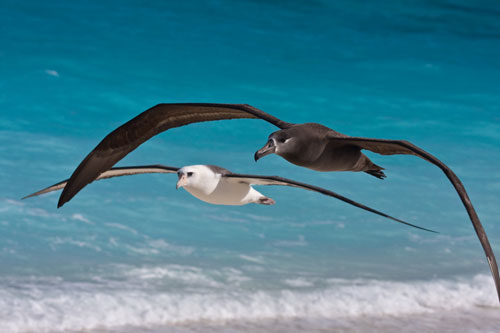Barbara Block (Biology Department, Hopkins Marine Station, Stanford University, California, USA) and colleagues writing in the journal Nature, have analysed results from the TOPP (Tagging of Pelagic Predators) programme, including the at-sea tracking of Laysan Phoebastria immutabilis and Black-footed P. nigripes Albatrosses and Sooty Shearwaters Puffinus griseus in the Pacific Ocean (click here).
The paper's abstract follows:
"Pelagic marine predators face unprecedented challenges and uncertain futures. Overexploitation and climate variability impact the abundance and distribution of top predators in ocean ecosystems. Improved understanding of ecological patterns, evolutionary constraints and ecosystem function is critical for preventing extinctions, loss of biodiversity and disruption of ecosystem services. Recent advances in electronic tagging techniques have provided the capacity to observe the movements and long-distance migrations of animals in relation to ocean processes across a range of ecological scales. Tagging of Pacific Predators, a field programme of the Census of Marine Life, deployed 4,306 tags on 23 species in the North Pacific Ocean, resulting in a tracking data set of unprecedented scale and species diversity that covers 265,386 tracking days from 2000 to 2009. Here we report migration pathways, link ocean features to multispecies hotspots and illustrate niche partitioning within and among congener guilds. Our results indicate that the California Current large marine ecosystem and the North Pacific transition zone attract and retain a diverse assemblage of marine vertebrates. Within the California Current large marine ecosystem, several predator guilds seasonally undertake north-south migrations that may be driven by oceanic processes, species-specific thermal tolerances and shifts in prey distributions. We identify critical habitats across multinational boundaries and show that top predators exploit their environment in predictable ways, providing the foundation for spatial management of large marine ecosystems."

Black-footed and Laysan Albatrosses flying along the shoreline at Midway Atoll
Photograph by Eric Vanderwerf
From an on-line report on the Nature article in Birdwatch magazine:
"Laysan and Black-footed Albatross showed different migratory directions despite often sharing the same Hawaiian breeding colonies, perhaps caused by the birds' ability to differentiate between seasonal changes and concentrations of food sources related to ocean temperature. Laysan Albatross largely foraged in the north-western pacific after dispersal, whereas Black-footed tended towards the north-east, and though there was substantial overlap in the central Pacific zone, it is clear that each species' niche is largely separate."
Reference:
Block, B.A., Jonsen, I.D., Jorgensen, S.J., Winship, A.J., Shaffer, S.A., Bograd, S.J., Hazen, E.L., Foley, D.G., Breed, G.A., Harrison, A.-L., Ganong, J.E., Swithenbank, A., Castleton, A.M., Dewar, H., Mate, B.R., Shillinger, G.L., Schaefer, K.M., Benson, S.R., Weise, M.J., Henry, R.W. & Costa, D.P. 2011. Tracking apex marine predator movements in a dynamic ocean. Nature 475: 86-90.
John Cooper, ACAP Information Officer, 26 November 2011

 English
English  Français
Français  Español
Español